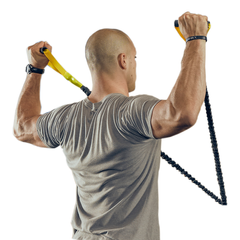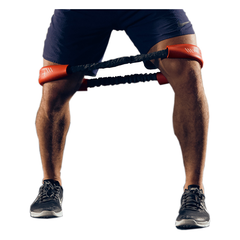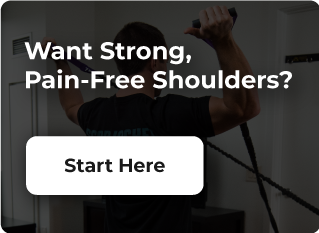Rotator cuff tears are common. Around 250,000 will be surgically repaired this year, and a couple million more will be treated via more conservative measures—ranging from rest, pain meds, injections, and therapy.
But get this…
A whole bunch of people will live with a rotator cuff tear and don’t even know about it. It’s believed that 25-40% amount of people will carry on their life pain-free. And that’s not just minor rotator cuff issues either. It’s shown that roughly 25% of people over 60 have full-thickness rotator cuff tears, which goes up to 50% for people in their 80s (ref).
The big question is, especially for those struggling with shoulder pain or potentially diagnosed with a cuff tear, what’s the secret to living through this injury pain-free?
We’ll address it plus more and put you on track to pain-free living.
Anatomy
Let’s start with a general understanding.
The rotator cuff describes the four muscles that create a ring of support for the arm bone in the socket—it establishes a cuff around the humeral head. These are often called the SITS muscles by exercise science students to remember their names as an easy acronym.

Although, this simple picture presents some misconceptions about the rotator cuff and how a tear occurs.
The first is a belief that tearing your rotator cuff is like splitting your pants. And while sometimes, it is this dramatic, a sudden tear like this requires a large amount of force to occur. The more common tear occurs over a lifetime, more like wearing a hole in your pants over years of use.
The next belief is that a rotator cuff tear will be forever limiting. The rotator cuff, along with other muscles, works together by combining their actions to keep the arm correctly placed in the shoulder socket—allowing it to roll, slide, and glide as needed.
This community effort is more evident by looking at a dissection rather than an anatomy illustration. There is continuity to the rotator cuff, which, to borrow from physical therapist Adam Meakins, secures the shoulder more like a large flat blanket.

(Source: Jorge Chahla)
The redundancy to the shoulder causes muscle groups to have overlapping jobs. If one of the muscles has a tear, there are still other ways to get the same motion. Improving the ability of different muscles to help with the job is how people live with tears unbeknownst to them and why progressing through a strengthening plan often works exceptionally well.
The important take-home is that while many considerations surround each person’s injury, not all rotator cuff tears need surgery!
The Cost of Surgery
If faced with the decision to rehab a rotator cuff tear or have surgery, most would do their best to avoid the latter. But still, it may seem appealing to bite the bullet and get it over.
Although there are several reasons why surgery is not the best option, some of which are obvious.
The top of many lists is that surgery is costly. Even with excellent health insurance, it will likely cost a few thousand dollars to cover the surgeon, anesthesiologist, surgical center, post-op therapy, and follow-up, plus many other add on costs. There is the expense that occurs from lost time from work and the overall disruption of your life.
After the cost, rotator cuff surgery requires a lengthy recovery. Expect a sling for about 6-weeks with some uncomfortable sleep, and then another 4-6 months to make a full recovery.
Beyond the expense, discomfort, and inconvenience, many aren’t aware that rotator cuff surgery often fails, and the tendon becomes re-torn (ref).
And even if the surgery is successful, a fix isn’t guaranteed like nothing ever happened. Many have stiffness, loss of mobility, and complain about a shoulder that doesn’t perform like it used to.
Due to these things, and the potential for success, a rehab plan is a great first step for many rotator cuff tear.
A Plan for Your Rotator Cuff
Now, in case you didn’t know, we sell a shoulder program that has been used by many to rehab their diagnosed rotator cuff tear, even after they’re told that surgery is the only option. So, yeah, we’re invested in getting you to go the route of NON-surgery, but I assure you that it’s more important to us than making a few dollars.
Allowing people to overcome their pain without the cost, pain, and risks involved with surgery is just as vital to us and as fulfilling as building a successful business.
Still, it would be unethical if the possibility of rehab wasn’t there. There is plenty of research and support in the medical community that the mere surgery process is a long route to the same end.
Consider what surgery leads to: forced rest and the treatment of inflammation (ice, anti-inflammatory medication, etc.,) then slowly reintroducing range of motion, then a carefully designed progressive return to strengthening exercises.
This process is likely the MOST impactful part… not even surgical repair.
What success would you have if you did all of those things and expected slow progress over 4-6 months without repairing the rotator cuff? It’s hard to say and remains disputed because, not surprisingly, nobody wants to get the sham surgery in a research study for their rotator cuff repair.
With that said, there are situations in which shoulder surgery has proven to be the best first approach. Generally, younger people with traumatic cuff tears should at least get it medically evaluated for the need for surgery. Meaning, if you took a nasty fall, resulting in a prominent, “Oh, crap” moment (especially under the age of 40), first see a sports medicine professional on the approach.
But suppose your pain was a gradual onset or started as just a twinge during a typical physical activity (like lifting a suitcase or even pumping heavy iron). In that case, a therapy plan is a great first approach.
With these cases, your body has had some time to build support structures in the form of scar tissue and strength from other muscle groups. With some time and focused strength and mobility work, you can further this support structure and most likely resolve the pain and return to one-hundred percent again…without the pains of surgery.
The Risk of the Conservative Approach
The question then is what the downside of a conservative approach is?
The biggest fear is that your shoulder will end up worse off. But the evidence shows that six weeks of physical therapy yields a very low risk of worsening things.
Regarding the time delay, it takes six weeks from initial evaluation, to an MRI, to follow-up, and then getting in for surgery. So don’t fret that your arm will end up worse if you’re not rushed off for an operation.
There is also concern that loading up an injured shoulder can only make things worse. But as mentioned earlier, this is important to the healing process by building a support structure around the tear.
Although, merely taking time off and then jumping back into things or pushing through the pain are not reliable strategies. The rehab process requires steps in which you restore mobility and progress through pain-free strengthening.
And please keep one thing in mind during the rehab process…
Be patient and give it your full effort!
Our bodies are DESIGNED to heal, yet if you expect to put in a few weeks of work and then be perfect, you’ll likely be disappointed. In many research studies, people get counted as “failed conservative attempts” at the 6-week mark, but what does it mean to fail?
A lot has to do with meeting the patient’s expectations set at the rehab program’s onset. When the sports med doctor throws out 6-weeks, many start a countdown clock to the day they’re good as new.
At 6-weeks, you might not be perfect, but that doesn’t mean that the rehab was unsuccessful. It’s merely a time to reassess how things are going and determine if it’s necessary to take different actions.
The Crossover Approach
Now we must evaluate the plan, which we discuss in-depth in our article: The Approach to Shoulder Pain
But the big priority for the plan is rest to allow for the resolution of inflammation around the injured area. However, if rest is interpreted as do nothing, it will not lead to success.
The better term is relative rest, which entails an active approach to improving your shoulder strength and mobility while avoiding things that might make it worse. Not only does this help build the necessary strength and stability to overcome the injury, but it keeps an athlete or active person from losing their mind during the rehab process.
Quite often, rehab’s downfall occurs when a person rushes back to things as they start to feel better.
We created our 30-Day Fix program with this in mind. With the help of our education and training, you can navigate the process of relative rest with something you can do every day to help improve your shoulders.
Along with progress checks based on what your shoulders can do without pain, you will progress back to full capacity.
You can follow this alongside your physical therapist’s guidance for a home program that will improve your outcomes. But many have had success using Crossover Symmetry alone, which we would be happy to support with the help of our medical team.
If you have questions about a rotator cuff tear or shoulder pain in general, please reach out at support@crossoversymmetry.com, and we would be happy to help!
 Shoulder Packages
Shoulder Packages
 Hip & Core Package
Hip & Core Package
 Bundles
Bundles
 Accessories
Accessories




















